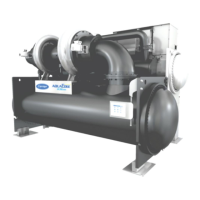106
9.3.12 – Inspect the Heat Exchanger Tubes and Flow Devices
9.3.12.1 Cooler and optional flow devices
Inspect and clean the cooler tubes at the end of the first operating season. Because these tubes have internal
ridges, a rotary-type tube cleaning system is necessary to fully clean the tubes.
Inspect the tubes’ condition to determine the scheduled frequency for future cleaning and to determine whether
water treatment in the chilled water/brine circuit is adequate.
Inspect the entering and leaving chilled water temperature sensors and flow devices for signs of corrosion or
scale. Replace a sensor or Schrader fitting if corroded or remove any scale if found.
Verify the flow and speed with the data in the Electronic Catalogue selection program for the unit.
9.3.12.2 Condenser and optional flow devices
Since this water circuit is usually an open-type system, the tubes may be subject to contamination and scale.
Clean the condenser tubes with a rotary tube cleaning system at least once per year and more often if the water is
contaminated.
Inspect the entering and leaving condenser water sensors and flow devices for signs of corrosion or scale.
Replace the sensor or Schrader fitting if corroded or remove any scale if found.
Verify the flow and speed with the data in the Electronic Catalogue selection program for the unit.
Higher than normal condenser pressures, together with the inability to reach full refrigeration load, usually indicate
dirty tubes or air in the chiller. If the refrigeration log indicates a rise above normal condenser pressures, check the
condenser refrigerant temperature against the leaving condenser water temperature.
If this reading is more than what the design difference is supposed to be, the condenser tubes may be dirty, water
flow may be incorrect, or non-condensables have contaminated the refrigerant circuit.
When the refrigeration logs indicates a rise above normal condenser pressures, check the purge pump out as
follow:
1. Check purge out frequency on HMI touch screen purge menu. If average pump out time per day is above
15 min. Please check the leak and repair it. Using purge to pump out remaining non-condensable inside
chiller.
2. If, however, purge pump out time per day is below 15 min, the high condenser pressure is caused by dirty
tubes or by abnormal conditions in the condensing water circuit such as restricted flow, etc..
3. Check operation of condensing water circuit. If water conditions (flow and temperature) appear normal,
the tubes should be cleaned.
During the tube cleaning process, use brushes specially designed to avoid scraping and scratching the tube wall.
Contact local Carrier representative to obtain these brushes. Do not use wire brushes
CAUTION: Scale may require chemical treatment for its prevention or removal. Consult a water treatment specialist
for proper treatment.
9.3.13 Water Leaks
The refrigerant moisture indicator on the refrigerant motor cooling line along with the moisture indicator located in
the liquid refrigerant feeding the compressor bearings indicates whether there is water or air leakage during chiller
operation. Water leaks must be repaired immediately.
CAUTION: The chiller must be dehydrated after repair of water leaks or damage may result. See Chiller
Dehydration section.
9.3.14 Water treatment
Untreated or improperly treated water may result in corrosion, scaling, erosion, or algae. The services of a
qualified water treatment specialist should be obtained to develop and monitor a treatment program.
CAUTION: Water must be within design flow limits, clean, and treated to ensure proper chiller performance and
reduce the potential of tube damage due to corrosion, scaling, erosion, and algae. Carrier assumes no responsibility
for chiller damage resulting from untreated or improperly treated water.
9.3.15 - Inspect / remove the power cabinet equipment
Before working on the electrical equipment, shut off the chiller. Ensure that no circuit is energized and that all are
isolated by a main disconnect switch.
Check the cable tightness.

